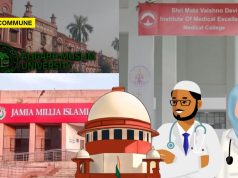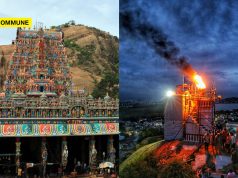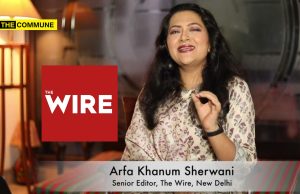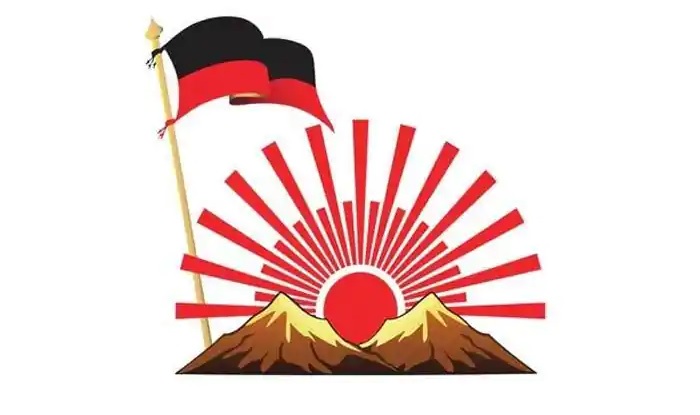
It is important to know the history of election symbols in India because a majority of the Indian population vote on the basis of the symbol. Some symbols have been etched in the minds of people and commands loyalty among its cadres. One of the political parties in India that has been able to have a symbol of its own since its inception is the Dravida Munnetra Kazhagam (DMK). Its symbol, the rising sun, still holds its sway among the people of Tamil Nadu. Odi Varugiran Udaya Suriyan penned and sung by Nagore Hanifa remains its propaganda song in its rallies. This symbol has not just shaped Tamil Nadu politics but has played its role at the national arena too. So, how did the party get this symbol that ushered in the era of Dravidian politics and has gone on to define one of the most powerful families in the world?
The story that we know
In 1948, there was a party called “Vanniyar Kula Kshatriyar Katchi” headed by S.S. Ramasamy Padayatchiyar with Govindasamy Padayatchiyar as its secretary. This party had the symbol of the rising sun. In 1951, the Vanniyars convened a major conference to organize Vanniyars into a political force. The conference resolved that the Vanniyars would contest the elections in solidarity with the “toiling masses” and the Tamil Nadu Toilers’ Party (TNTP) was founded in the year 1951 by Ramasamy Padayatchiyar.
In the first General Elections held in 1952 the TNTP won 19 seats in the Madras Legislative Assembly. When Rajagopalachari resigned as Chief Minister of the Madras state and was replaced by Kamaraj, the TNTP decided to extend its support and Ramasamy Padayatchi became a member of Kamaraj’s cabinet. Later, the TNTP was dissolved.
Govindasamy Padayatchiyar came out and started his own outfit called the Workers’ Party. The Workers’ Party was advised to get a symbol of its own by C. Annadurai. This symbol was the rising sun.
In the rally held in 1956 by the DMK, it was resolved that the DMK would contest the elections in 1957. At that time, Annadurai requested the Election Commission to allot the rising sun symbol of Workers’ Party to the DMK saying that Govindasamy Padayatchiyar had dissolved the Workers’ Party and merged with the DMK and that Govindasamy’s cadres had won using the support extended by the DMK. Since then, till today, the DMK for more than six decades has had the ‘rising sun’ as its symbol.
There were threats to the symbol when M.G. Ramachandran split from the DMK in 1972 to form All India Anna Dravida Munnetra Kazhagam (AIADMK) and again when Vaiko parted ways to form his own party Marumalarchi Dravida Munnetra Kazhagam (MDMK) in 1994. Vaiko took enormous efforts to appropriate the symbol to his own party. Back then he is said to have mentioned that the rising sun symbol was brought to life by Anna and is the property of his ‘paattan’ (grandfather) Anna in which he also has claim and that Karunanidhi cannot claim it as his own personal property. But Vaiko couldn’t submit enough evidence to claim the symbol.
This is a known story of how the DMK has been able to keep the rising son symbol for its own. But there exists a hidden history behind the symbol that not many know. A history of how a party exploited the efforts spearheaded by one of the greatest revolutionaries Tamil Nadu has ever seen.
The hidden history
In 1929, a rally of the Self-Respect Movement happened in Chengelpet. For the rally, a flag was designed that had sun emitting four rays with the pictures of four leaders – Theagaraya Chetty, T.M. Nair, Panagal Arasar, and Periyar E.V. Ramasamy. This flag was designed by Thatha Rettamalai Srinivasan who also led the rally at Chengelpet.
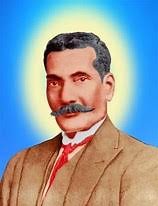
Ten years later in 1939, Thatha Rettamalai Srinivasan started the Madras Province Scheduled Castes’ Federation with Dr. Ambedkar’s support. This federation took the form of a political party which was popularly and colloquially known as “Surya Katchi” because the party’s flag had a sun in it. A magazine for the Madras Province Scheduled Caste federation that was published from Gudiyattam near Vellore had for the first time carried the symbol of a rising sun emerging from two mountains (Rettamalai in Tamil means 2 mountains).
Now this can be washed off as a story meant to discredit the DMK. But, the truth put out here has been documented by Dr. Nirmala herself, who is the granddaughter of Thatha Rettamalai Srinivasan.
The history of Rettamalai Srinivasan and his contribution towards emancipation of Dalits has been marginalized and doesn’t find a place in the mainstream. Born into the Paraiyar caste he was a close associate of both Gandhi and Ambedkar. He is considered to be one of the pioneers of the scheduled caste movement in Tamil Nadu. He is the brother-in-law of Iyothee Thass, another prominent anti-caste leader. He worked as a translator in South African court where Gandhi was practicing as a barrister. It was him who taught Gandhi how to sign M.K. Gandhi in Tamil.

He established the Paraiyar Mahajana Sabha and represented the Paraiyars in the first two round table conferences held in London along with Babasaheb Ambedkar.
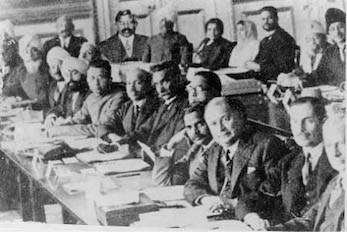
When the Temple Entry Disabilities Bill was introduced in the Madras Legislative Council in November 1932, Rettamalai Srinivasan described it as a modest and said “whether the God is inside the temple or not, but I am the original inhabitant of this soil and I must have the birth right or civil right to move an where and everywhere in my land weather it is a land or sea, road or temple”. When Ambedkar decided to convert to Buddhism, he issued a statement asking him to reconsider his decision. However, like Ambedkar, he too believed that Gandhi’s approach would not lead to upliftment of Dalits but was of the stance that legislations in favour of temple entry would definitely help in the amelioration of Dalits.
So, the original creator and the proprietor of the rising sun symbol was none other than the firebrand Dalit leader Thatha Rettamalai Srinivasan. But never has the DMK that lectures others on social justice has ever acknowledged Rettamalai Srinivasan and his contribution towards the upliftment of Dalits in Tamil Nadu.

